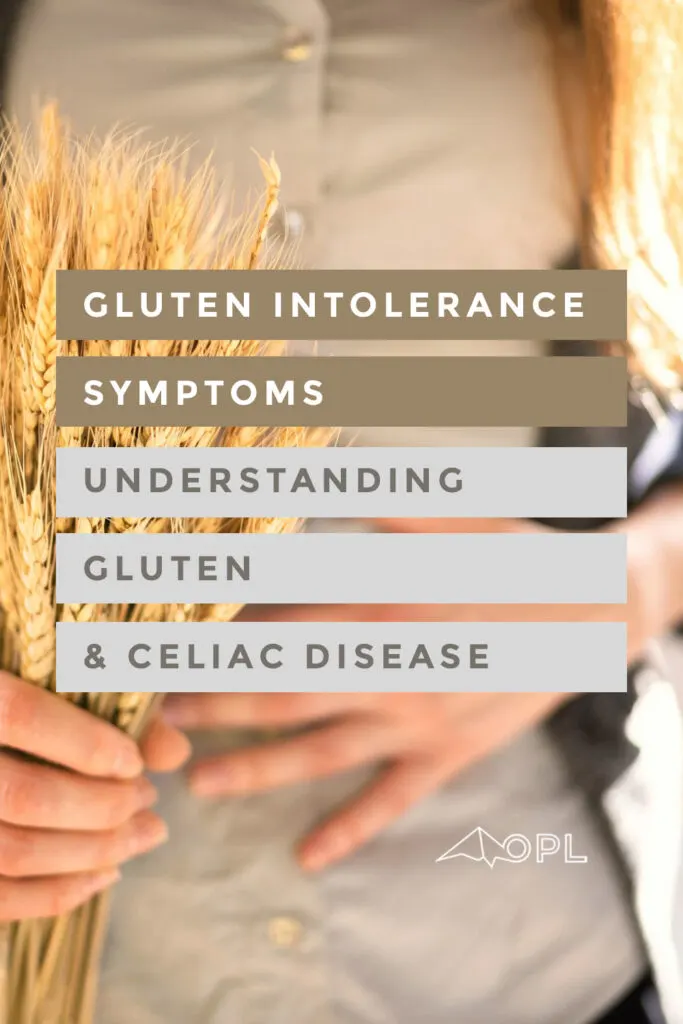Learn about gluten, gluten intolerance, celiac disease, wheat allergy and their symptoms, causes, and complications. Understand the difference between gluten allergy and wheat allergy and the timeline of celiac disease.

What is Gluten?
Gluten is a protein found in grains such as wheat, barley, and rye. It helps give bread and other baked goods their texture and shape. Some people have a medical condition called celiac disease, in which they are unable to consume gluten without experiencing adverse symptoms. For these individuals, a gluten-free diet is necessary to manage their condition. Additionally, some people without celiac disease still choose to follow a gluten-free diet for various reasons, such as gluten sensitivity or personal preference.

Why do some people have issues with consuming Gluten?
Some people have a medical condition called celiac disease, in which they are unable to consume gluten without experiencing adverse symptoms. This is an autoimmune disorder where the immune system reacts to gluten by damaging the lining of the small intestine, which can lead to malabsorption of nutrients.
Another condition is non-celiac gluten sensitivity (NCGS) which is a condition where people experience symptoms similar to celiac disease, but do not have the same damage to their small intestine and test negative for celiac disease. It’s believed that gluten may cause an immune response or an inflammatory response in the gut, resulting in symptoms.
Why is it possible for Gluten to cause issues?
Some researchers suggest that gluten may cause damage to the gut lining, leading to increased gut permeability (leaky gut) and allowing gluten peptides to pass through and reach the immune system causing an inflammatory response.
It’s also worth noting that gluten can be found in many processed food products, and it is often added as a thickener, filler, or stabilizer. So, people with gluten sensitivity may experience symptoms due to consuming gluten indirectly through these products.
What’s the Difference Between Gluten Sensitivity and Celiac Disease?
The main difference between gluten sensitivity and celiac disease is the way in which the body reacts to gluten.
Celiac disease is an autoimmune disorder where the immune system reacts to gluten by damaging the lining of the small intestine. This damage can lead to malabsorption of nutrients, and can cause a wide range of symptoms such as diarrhea, abdominal pain, bloating, and weight loss. People with celiac disease also test positive for specific antibodies (IgA tissue transglutaminase) and biopsy of the small intestine usually shows damage to the villi (small finger-like projections that line the small intestine) which is typical of this condition.
On the other hand, non-celiac gluten sensitivity (NCGS) is a condition where people experience symptoms similar to celiac disease, but do not have the same damage to their small intestine and test negative for celiac disease. It’s believed that gluten may cause an immune response or an inflammatory response in the gut, resulting in symptoms.
Sensitivity to Gluten is considered a real phenomenon by many experts, and a gluten-free diet can alleviate symptoms.
What is gluten intolerance?

The term “gluten intolerance” is often used to describe a wide range of symptoms that people with gluten intolerance experience after consuming gluten, but it is not a clinically recognized condition (but I’m sure it will be soon). It’s often used as an umbrella term that can include celiac disease, non-celiac gluten sensitivity (NCGS), and other conditions that have similar symptoms.
Non-celiac gluten sensitivity (NCGS) is also a clinically recognized condition characterized by symptoms similar to celiac disease.
It’s worth noting that symptoms can be caused by other factors, such as food allergies or sensitivities, or other underlying medical conditions, so it is important to consult with a trusted healthcare professional to determine the cause of symptoms and develop an appropriate treatment plan to find out if you’re gluten intolerant.
Is gluten intolerance considered a gluten allergy?
No, gluten intolerance is not considered a gluten allergy.
A gluten allergy is an immune reaction to gluten proteins. This is different from celiac disease, which is an autoimmune disorder where the immune system mistakenly attacks the small intestine in response to gluten.
A gluten allergy can cause symptoms such as hives, itching, and anaphylaxis (a severe, potentially life-threatening allergic reaction). However, this type of gluten allergy is very rare.
What Are Gluten Allergy Symptoms?

Symptoms of a gluten allergy can include:
- Hives or rash
- Itching
- Swelling of the face, lips, tongue, and throat
- Trouble breathing or wheezing
- Abdominal pain
- Diarrhea
- Nausea or vomiting
- Anaphylaxis (a severe, potentially life-threatening allergic reaction)
It’s important to note that gluten allergies are extremely rare, and most people who experience symptoms after consuming gluten are likely experiencing symptoms due to celiac disease or non-celiac gluten sensitivity (NCGS).
What Causes a Gluten Allergy?
The exact cause of gluten allergies is not well understood. Gluten allergies are considered to be a type of food allergy, which occurs when the immune system mistakenly identifies a food protein as harmful and launches an immune response against it. The immune response can cause a range of symptoms, including those that affect the skin, gastrointestinal system, and respiratory system.
What is a wheat allergy and is it different than a gluten allergy?
A wheat allergy is an immune reaction to one or more proteins found in wheat. This is different from a gluten allergy, which is an immune reaction to gluten, a protein found in wheat, barley, and rye.
Symptoms of a wheat allergy can include:
- Hives or rash
- Itching
- Swelling of the face, lips, tongue, and throat
- Trouble breathing or wheezing
- Abdominal pain
- Diarrhea
- Nausea or vomiting
- Anaphylaxis (a severe, potentially life-threatening allergic reaction)
Symptoms can appear immediately after consuming wheat or within a few hours, and they can range from mild to severe. People who eat gluten, foods that contain gluten may have a mild reaction to wheat but severe reactions can be life-threatening.
Signs and Symptoms of Gluten Intolerance
Symptoms of gluten intolerance, also known as non-celiac gluten sensitivity (NCGS) can vary widely from person to person and can include:
- Gastrointestinal symptoms such as abdominal pain, bloating, gas, diarrhea, intestinal pain, and constipation.
- Fatigue
- Headaches
- Brain fog or difficulty concentrating
- Joint or muscle pain
- Depression or anxiety
- Numbness or tingling in the hands and feet
- Skin rashes or eczema
It’s worth noting that the symptoms of NCGS can be similar to those of celiac disease and other medical conditions, so it is important to consult with a healthcare professional to determine the cause of symptoms and develop an appropriate treatment plan. Unlike Celiac disease, NCGS does not cause damage to the small intestine and is not diagnosed with a biopsy. A diagnosis is usually made after ruling out other conditions and the person’s symptoms improve on a gluten-free diet.
Symptoms of Celiac Disease

Symptoms of celiac disease can vary widely from person to person and can include:
- Gastrointestinal symptoms such as abdominal pain, bloating, gas, diarrhea, and constipation.
- Fatigue
- Unexplained weight loss
- Anemia (a lack of iron in the blood)
- Bone or joint pain
- Depression or anxiety
- Numbness or tingling in the hands and feet
- Skin rashes or eczema
- Infertility or recurrent miscarriages
- Delayed growth or failure to thrive in children
It’s worth noting that not all people with celiac disease have obvious symptoms, and some may have only mild or no symptoms at all. Some people may have symptoms that are not related to the digestive system, such as anemia or bone pain. This is why celiac disease is often referred to as a “silent” or “stealth” disease.
A definitive diagnosis of celiac disease is made with a combination of blood tests and a biopsy of the small intestine, which shows damage to the villi (small finger-like projections that line the small intestine) that is typical of this condition. A gluten-free diet is the only treatment for celiac disease, and it is necessary to follow a strict gluten-free diet to avoid further damage to the small intestine and to alleviate symptoms.
Celiac Disease Causes and Risk Factors
The exact cause of celiac disease is not fully understood, but it’s believed to be a combination of genetic and environmental factors.
Genetics
- Celiac disease is more common in people who have a family history of the condition. It is estimated that about 1 in 22 people with a first-degree relative (parent, child, sibling) with celiac disease will develop the condition.
- Certain genetic variations, particularly in the HLA-DQA1 and HLA-DQB1 genes, are associated with an increased risk of celiac disease.
Environmental Factors
- Gluten is a protein found in wheat, barley, and rye, and it is responsible for triggering the immune response in people with celiac disease.
- Exposure to gluten is necessary to develop celiac disease, but it’s not sufficient. It is believed that other environmental factors, such as a viral or bacterial infection, pregnancy, childbirth, or severe emotional stress, may trigger the onset of the disease in people who are genetically predisposed.
Risk Factors
- A family history of celiac disease or type 1 diabetes
- A personal history of autoimmune disorder
- Having Down syndrome, Turner syndrome, or Williams syndrome
- Being of European descent
It’s worth noting that not everyone who has these risk factors will develop celiac disease, and some people may develop the condition without any known risk factors.
Celiac Disease Complications

Celiac disease can cause a wide range of complications if left untreated. Some of the most common complications include:
- Malabsorption: The damage to the lining of the small intestine caused by celiac disease can lead to malabsorption of nutrients, which can cause a wide range of symptoms and lead to nutrient deficiencies. Nutrients that are commonly affected include iron, calcium, vitamin D, vitamin K, and vitamin B12.
- Anemia: Iron-deficiency anemia is a common complication of celiac disease, due to malabsorption of iron. Anemia can cause fatigue, weakness, and an increased risk of infections.
- Osteoporosis: A lack of calcium and vitamin D can lead to osteoporosis, a condition characterized by weak bones and an increased risk of fractures.
- Lactose intolerance: Damage to the lining of the small intestine can lead to lactose intolerance, a condition characterized by difficulty digesting lactose, a sugar found in milk and dairy products.
- Lymphoma and other cancers: People with untreated celiac disease have an increased risk of developing lymphoma and other types of cancer, particularly of the small intestine.
- Other autoimmune disorders: People with celiac disease have an increased risk of developing other autoimmune disorders such as Type 1 diabetes, autoimmune thyroid disease, and autoimmune liver disease.
- Reproductive and pregnancy-related issues: untreated celiac disease can lead to infertility, recurrent miscarriages, and other pregnancy-related complications.
It’s worth noting that strict adherence to a gluten-free diet can prevent or alleviate most of these complications and can improve the overall health of people with celiac disease.
How many people are sensitive to gluten?
Given the increase of autoimmune diseases and the correlation with wheat consumption, a significant number of Americans have been found to be at high risk for gluten sensitivity. This includes those with autoimmune disorders, irritable bowel syndrome, chronic headaches, and/or microscopic colitis. According to Dr. Fine (source), around 60-65% of individuals with these conditions test positive for gluten sensitivity through Enterolab testing. Furthermore, around 20-25% of individuals without any symptoms are found to have gluten sensitivity through Enterolab testing. Therefore, it’s estimated that roughly one in two people are gluten-sensitive.
When did humans start consuming wheat?

Humans have been consuming wheat for thousands of years. The origins of wheat cultivation can be traced back to the Fertile Crescent, a region that encompasses parts of present-day Iraq, Syria, Lebanon, Jordan, Israel, and Egypt. It’s believed that wild grasses, including emmer and einkorn wheat, were first domesticated in this region around 10,000-12,000 years ago. These early forms of wheat were used to make a type of flatbread.
As human populations grew and began to settle in one place, the cultivation of wheat and other cereal crops became increasingly important. The development of farming techniques, such as irrigation and plow, also allowed for the growth of larger quantities of wheat.
Over time, different varieties of wheat were developed and spread to different parts of the world, such as durum wheat, used to make pasta, and spelt and kamut, which are ancient varieties of wheat. Today, wheat is one of the most widely grown and consumed cereal crops in the world.
Did people always have health issues consuming wheat?
It’s not clear if people always had health issues from consuming wheat, as there is limited historical information available on the subject. However, it’s believed that the wheat consumed by our ancestors was different from the wheat consumed today. The wheat of the past was smaller, harder, and had a much lower gluten content than modern wheat. This is because modern wheat has been selectively bred for higher yields and better baking characteristics, which has led to an increase in gluten content.
When did wheat start to have more gluten?
Wheat has a naturally high gluten content, but the gluten content of wheat has been increased over time through selective breeding.
The process of selective breeding for wheat began around the early 20th century, when scientists and farmers started to cross different varieties of wheat to create new ones with specific characteristics, such as higher yields, disease resistance, and better baking characteristics. This process has led to the development of modern wheat varieties that have higher gluten content than the wheat varieties of the past.
The gluten content of wheat can vary depending on the variety, but it is estimated that the gluten content of modern wheat is around 2-3 times higher than that of ancient wheat.
Post Review
- Gluten is a protein found in wheat, barley, and rye, and it is responsible for triggering the immune response in people with celiac disease.
- Celiac disease is an autoimmune disorder that causes damage to the small intestine when gluten is consumed.
- Non-celiac gluten sensitivity (NCGS) is a condition where people experience symptoms similar to celiac disease but do not have the same damage to the small intestine caused by gluten.
- Gluten intolerance, Gluten sensitivity and Celiac disease are different conditions, and it’s important to consult with a healthcare professional to determine the cause of symptoms.
- Gluten allergy is extremely rare and most people who experience symptoms after consuming gluten are likely experiencing symptoms due to celiac disease or non-celiac gluten sensitivity (NCGS).
- Symptoms of gluten intolerance, also known as non-celiac gluten sensitivity (NCGS) can vary widely from person to person and can include: gastrointestinal symptoms, fatigue, headaches, brain fog, joint or muscle pain, depression or anxiety, numbness or tingling in the hands and feet and skin rashes or eczema.
- Symptoms of celiac disease can vary widely from person to person and can include: gastrointestinal symptoms, fatigue, unexplained weight loss, anemia, bone or joint pain, depression or anxiety, numbness or tingling in the hands and feet, skin rashes or eczema, infertility or recurrent miscarriages, and delayed growth or failure to thrive in children.
- Symptoms of a wheat allergy can include: hives or rash, itching, swelling of the face, lips, tongue, and throat, trouble breathing or wheezing, abdominal pain, diarrhea, nausea or vomiting, and anaphylaxis.
- The exact cause of celiac disease is not fully understood, but it is believed to be a combination of genetic and environmental factors.
- Celiac disease can cause a wide range of complications if left untreated, including malabsorption of nutrients, anemia, osteoporosis, lactose intolerance, an increased risk of lymphoma and other types of cancer, as well as other autoimmune disorders, reproductive and pregnancy-related issues.
- The gluten content of wheat has been increased over time through selective breeding, creating a gluten content of modern wheat is around 2-3 times higher than that of ancient wheat.
- The exact timeline of when celiac disease began to rise is not well understood, but it has only been recognized as a separate condition since the 1940s and the number of people diagnosed with celiac disease has increased in recent years, but it’s not clear if this is due to an actual increase in the number of people with the disease or if it is due to improved awareness and diagnostic methods.
- A wheat allergy is an immune reaction to one or more proteins found in wheat and it is different from a gluten allergy, which is an immune reaction to gluten, a protein found in wheat, barley, and rye.
Pin it


Dwayne Colt
Monday 30th of January 2023
My cousin has celiac disease, it's hard to find gluten-free food when eating. Usually, he just brings or prepares his own food when we go out to eat.
Lisa
Thursday 19th of January 2023
Excellent article-summarizes the differences in the afflictions many suffer with, including two of our adult children and my 91 yr old mother-in-law (who almost died from it in her much younger years before they knew what Celiac really was).